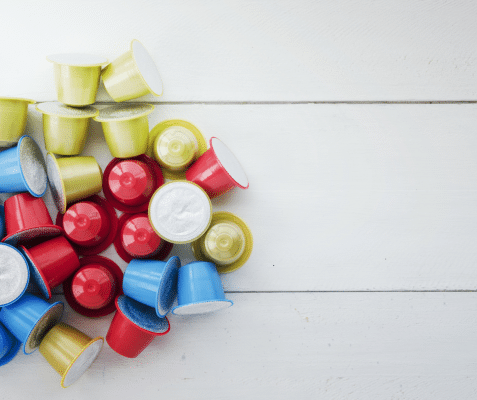The Dark Side of Convenience: Coffee K-Cup Pods and Environmental Impact
Rising Global Demand for K-Cup Pods and the Environmental Challenges Ahead
- K-Cup pods have become a household staple: Projections suggest that by 2025, the global market for these pods will exceed $29 billion.
- Currently, these predominantly plastic pods are immensely popular in Europe and North America, with forecasts indicating a surge in demand in Asian markets, notably China and South Korea.
- With the burgeoning global demand for K-Cup pods comes a corresponding rise in waste: Annually, the global footprint of discarded K-Cup pods amounts to approximately 576,000 metric tons — equivalent to the combined weight of about 4,400 school buses.
- In response to mounting environmental concerns, exemplified by initiatives like “Kill the K-Cup,” coffee companies are introducing capsules crafted from aluminum or compostable fiber. However, efforts to mitigate the pollution stemming from coffee pods remain sluggish.
Falsehoods piled on falsehoods
In 2021, Keurig, the producer of K-cups, shifted all its coffee pods from a nearly non-recyclable plastic to recyclable polypropylene. Users are advised to strip the lid from spent capsules, clear out the coffee grounds, and place the plastic pods into their recycling bins. These are then forwarded to local recycling centers, depending on the consumer’s location. Keurig importantly notes in fine print that recycling availability may vary: “check locally, not recycled in all communities.”
The issue at hand is that even though some individuals dispose of their coffee capsules in recycling bins, the majority of recycling facilities, known as Material Recovery Facilities (MRFs), cannot process items smaller than 7.5 centimeters (3 inches). A Greenpeace report highlights that only one MRF in the U.S. currently accepts coffee pods made from polypropylene.
Halo, a Keurig competitor that produces compostable coffee capsules, estimates that globally, 39,000 capsules are produced every minute, with up to 29,000 of these ending up in landfills—an outcome they describe as “insane.” It’s estimated that small plastics like coffee pods could take up to 500 years to decompose in landfills, releasing harmful chemicals into the soil and water. In Brazil, a mere 11% of used capsules were recycled in 2017; Hamburg, Germany, even banned coffee pods in 2016 to reduce waste and pollution.
Keurig claims on its website that its tests with MRFs have proven that small plastics can indeed be recovered and sorted along with other plastics. However, Howard Hirsch, a public interest lawyer in California, argues that the fossil fuel industries, major producers of plastic, have perpetuated the myth that continued production of new plastics is unnecessary, asserting that old plastics can be recycled into new products. According to Hirsch, “The whole system is essentially a lie built upon a lie.”
Keurig Green Mountain recently settled a class-action lawsuit for $10 million, addressing claims that it misled consumers about the recyclability of its K-cup pods. While Keurig admitted no wrongdoing, the settlement includes a commitment to clearer labeling on K-Cup pods, now stating in a larger font: “Check Locally — Not Recycled in Many Communities.”
“We didn’t win based purely on the merits,” admits Hirsch, who represented the plaintiffs, “but we consider it a victory as it forced Keurig to amend their product labeling and contribute $10 million. It sends a clear message to other firms about the importance of honesty in marketing the recyclability of their products.”
In a separate case, Keurig Canada agreed to pay a C$3 million ($2.2 million) fine in early 2022 for misleading claims that its single-use K-Cup pods were recyclable. Keurig has not commented on these matters publicly.
The European Union introduced a proposal in November 2022 for new regulations aimed at significantly reducing packaging waste, including coffee pods. These proposed rules, still pending approval from EU member states and the European Parliament, would mandate that all packaging be designed to be recyclable and ensure that it is actually recycled on a large scale by 2035.
Can Aluminum K-Cup Pods Solve the Problem?
In a sponsored advertisement for Nestlé’s Nespresso brand, George Clooney asserts, “Nespresso’s sustainability program is unmatched … for those who are conscientious and wish to genuinely recycle, it’s remarkably straightforward.”
To attract environmentally conscious customers, companies such as Nespresso have begun offering coffee capsules made of aluminum. Nespresso provides special recycling bags that consumers can send back to Nespresso’s stores or its recycling center, where the aluminum is purportedly reintegrated into the aluminum supply chain.



